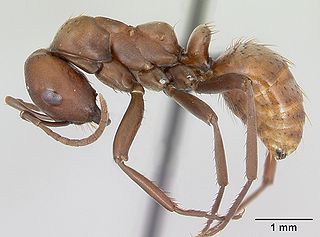
Polyergus, also called Amazon ants, is a small genus of 14 described species of "slave-raiding" ants. Its workers are incapable of caring for brood, in part due to their dagger-like, piercing mandibles, but more importantly, because in the evolution of their parasitism on certain species of the host genus Formica, they have lost the "behavioral wiring" to carry out even rudimentary brood care, or even to feed themselves. Polyergus workers exist in essence as a specialized brood-acquiring caste in their mixed Polyergus/Formica colonies, maintaining the Formica worker force by robbing brood, especially pupae, of particular species in the closely related genus Formica in massive colony-to-colony raids. The captured ants are generally referred to as "slaves" in scientific and popular literature, though recent attempts have been made to apply other human cultural models, such as describing the Polyergus individuals of a colony as "raiders" or "pirates" or "kidnappers" and the Formica workers as "helper-ants", or "domesticated animals". Biologists describe the system as parasitism by "dulosis" (slavemaking) by Polyergus on the host Formica species.

Dorymyrmex insanus is a species of pyramid ant, one of several species known as crazy ants, for their "frenetic" movement and swarming behavior. It is found in hot, dry habitats in the southern parts of the United States, much of Central America, and tropical South America. Dorymyrmex insanus is listed as Vulnerable by the International Union for Conservation of Nature (IUCN).

Dorymyrmex bicolor is a species of ant in the Dolichoderinae subfamily. Dorymyrmex bicolor was recently known as Conomyrma bicolor but has been renamed to Dorymyrmex bicolor. Dorymyrmex bicolor has a single petiole and a slit-like orifice which releases chemical compounds. This ant does not have the capability to sting. Dorymyrmex bicolor is primarily found in arid desert regions in Central and South America and the southwestern United States.
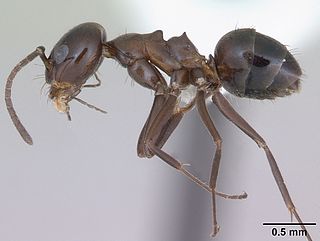
Dorymyrmex bituber is a species of ant in the genus Dorymyrmex. Described by Santschi in 1916, the species is endemic to Argentina and Paraguay.
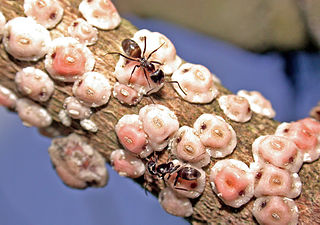
Dorymyrmex brunneus is a species of ant in the genus Dorymyrmex. Described by Forel in 1908, the species is endemic to several nations in South America.
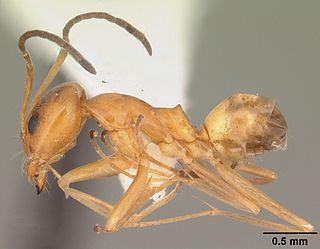
Dorymyrmex bureni also known as pyramid ant is a species of ant in the genus Dorymyrmex. Described by Trager in 1988, the species is endemic to the United States and Mexico. Pyramid ants are medium-sized ants, ranging from 2–4 mm. They are light orange in color and fast moving. Unlike other ants in the area like red imported fire ants, this species is not aggressive towards humans. The workers have a foul smelling coconut odor when crushed. Dorymyrmex bureni hunt living insects, even other winged ants. They also search for sap-sucking insects from which they collect honeydew. On the head of these ants are curved hairs, used for transporting beads of damp sand. Colonies are small. Nests usually have a single entrance with a mound of sand shaped like a crater. Dorymyrmex bureni prefer sandy soil. This species of ant is not an indoor pest, and pesticides should not be used. They are found throughout Florida.
Dorymyrmex chilensis is a species of ant in the genus Dorymyrmex. Described by Forel in 1911, the species is endemic to Chile.

Dorymyrmex elegans is a species of ant in the genus Dorymyrmex. Described by Trager in 1988, the species is endemic to the United States and Mexico, where it is a nocturnal species and is normally seen on cool days.

Dorymyrmex flavopectus is a species of ant in the genus Dorymyrmex. Described by Smith in 1944, the species is endemic to the United States and Mexico.

Dorymyrmex flavus is a species of ant in the genus Dorymyrmex. Described by McCook in 1879, the species is endemic to the United States and Mexico.

Dorymyrmex goeldii is a species of ant in the genus Dorymyrmex. Described by Forel in 1904, the species is endemic to Brazil.

Dorymyrmex grandulus is a species of ant in the genus Dorymyrmex. Described by Forel in 1922, the species is endemic to the United States.

Dorymyrmex lipan is a species of ant in the genus Dorymyrmex. Described by Snelling in 1995, the species is endemic to the United States and Mexico.
Dorymyrmex morenoi is a species of ant in the genus Dorymyrmex. Described by Bruch in 1921, the species is endemic to Argentina.

Dorymyrmex paiute is a species of ant in the genus Dorymyrmex. Described by Snelling in 1995, the species is endemic to the United States.

Dorymyrmex paranensis is a species of ant in the genus Dorymyrmex. Described by Santschi in 1922, the species is endemic to Paraguay.
Dorymyrmex reginicula is a species of ant in the genus Dorymyrmex. Described by Trager in 1988, the species is endemic to the United States.
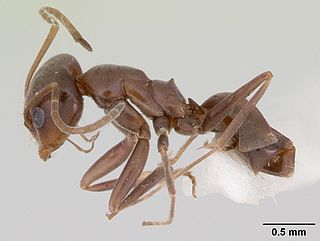
Dorymyrmex smithi is a species of ant in the genus Dorymyrmex. Described by Cole in 1936, the species is endemic to the United States and Mexico.

Dorymyrmex wheeleri is a species of ant in the genus Dorymyrmex. Described by Kusnezov in 1952, the species is endemic to the United States.


















